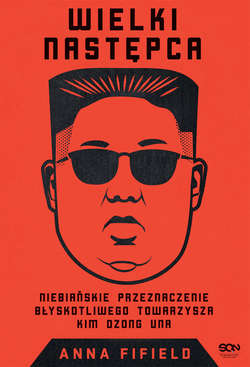Читать книгу Wielki Następca. Niebiańskie przeznaczenie błyskotliwego towarzysza Kim Dzong Una - Anna Fifield - Страница 11
На сайте Литреса книга снята с продажи.
Przypisy końcowe Rozdział I. Początki
Оглавление[1] „Korean Pictorial” 1986, nr styczniowy.
[2] Lee U Hong, Angu na kyowakoku: Kita Chosen kogyo no kikai, Tokyo, Aki shobo, 1990, s. 20.
[3] Ibidem, s. 32, 118, 168.
[4] Yi Han-yong, Taedong River Royal Family: My 14 Years Incognito in Seoul, Seoul, Dong-a Ilbo, 1996.
[5] Ju-min Park, James Pearson, In Kim Jong Un’s Summer Retreat, Fun Meets Guns, „Reuters”, 10.10.2017.
[6] Kim Ir Sen, With the Century, t. 2, Pjongjang, Foreign Languages Publishing House, 1992, s. 54.
[7] Szczegóły dotyczące planów Stalina wobec Kim Ir Sena, Cho Man Sika, a także bankietów Kim Ir Sena, za: Blaine Harden, The Great Leader and the Fighter Pilot, Nowy Jork, Penguin Books, 2015, s. 64–66.
[8] Szczegóły dotyczące powrotu Kim Ir Sena do Korei Północnej i poglądów Sowietów na jego temat, za: Bradley K. Martin, Under the Loving Care of the Fatherly Leader: North Korea and the Kim Dynasty, New York, Griffin, 2006, s. 46–52.
[9] Szczegóły dotyczące przyjęcia Kim Ir Sena na zjeździe, za: B. Harden, The Great Leader and the Fighter Pilot…, s. 67.
[10] B.K. Martin, Under the Loving Care…, s. 52–53; Andrei Lankov, The Real North Korea: Life and Politics in the Failed Stalinist Utopia, Oxford, Oxford University Press, 2014, s. 6.
[11] Baik Bong, Kim Il Sung, t. 2, Tokyo, Miraisha Publishing, 1970, s. 55–56.
[12] B.K. Martin, Under the Loving Care…, s. 67.
[13] Bruce Cumings, The Korean War: A History, New York, Modern Library Edition, 2010, s. 152.
[14] Blaine Harden, The US War Crime North Korea Won’t Forget, „Washington Post”, 24.03.2015.
[15] Strategic Air Warfare: An Interview with Generals Curtis E. LeMay, Leon W. Johnson, David A. Burchinal, and Jack J. Catton, Richard H. Kohn, Joseph P. Harahan (red.), Office of Air Force History, US Air Force, 1988, s. 88.
[16] „Record of a Conversation with Illarion Dmitriyevich Pak, Chairman of the Jagang Provincial People’s Committee”, 13.04.1955, History and Public Policy Program Digital Archive, RGANI fond 5, opis 28, delo 314., tłum. dla NKIDP Gary Goldberg. https://digitalarchive.wilsoncenter.org/document/116308.
[17] Suh Dae-sook, Kim Il Sung: The North Korean Leader, New York, Columbia University Press, 1988, s. 302.
[18] Don Oberdorfer, The Two Koreas: A Contemporary History, New York, Little, Brown and Company, 1998, s. 347.
[19] „GDR Ambassador Pyongyang to Ministry for Foreign Affairs, Berlin”, 14.04.1975, History and Public Policy Program Digital Archive, Political Archive of the Foreign Office, Ministry of Foreign Affairs (PA AA, MfAA), C 6862.
[20] Kim Hakjoon, Dynasty: The Hereditary Succession Politics of North Korea, Stanford, Shorenstein Asia-Pacific Research Center, 2017, s. 87.
[21] Kim Dzong Il, Brief History, Pjongjang, Foreign Languages Publishing House, 1998.
[22] D. Oberdorfer, The Two Koreas…, s. 341.
[23] David Sanger, Kim Il Sung Dead at 82, „New York Times”, 09.07.1994.
[24] Anna Fifield, Selling to Survive, „Financial Times”, 20.11.2007.
[25] Kim H., Dynasty…, s. 131.
[26] Ri Nam Ok, kuzynka Kim Dzong Nama, sądziła, że za ruchem tym stała Ko Yong Hui. Za nieopublikowaną książką Imogen O’Neil The Golden Cage: Life with Kim Jong Il, a Daughter’s Story.
[27] I. O’Neil, The Golden Cage…
[28] Kim H., Dynasty…, s. 153.
[29] Kenji Fujimoto, I Was Kim Jong-il’s Cook, Tokyo, Fusosha Publishing, 2003.
